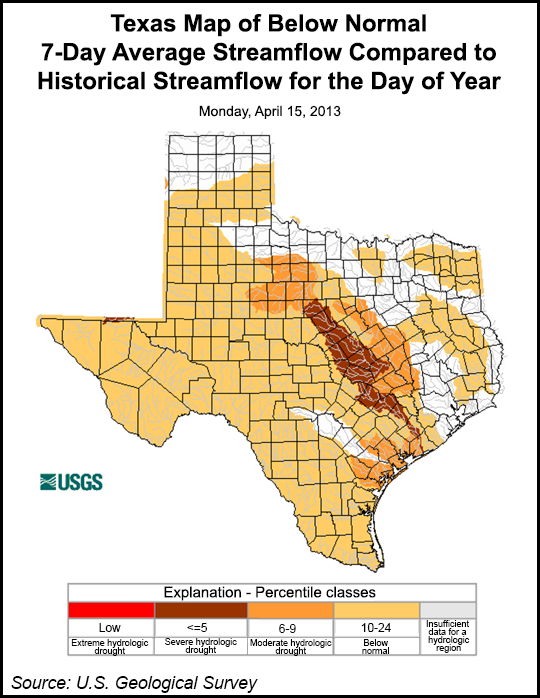NGI Archives | NGI All News Access
EDF: Two-Dozen Texas Counties Represent Biggest Water Concerns
While water use for hydraulic fracturing (fracking) in drought-stricken Texas is considered modest when compared to other uses, such as for agriculture, where the water is drawn from is a significant consideration, according to an analysis by the Environmental Defense Fund (EDF).

EDF found that the majority of water used for Texas oil and gas development in 2011 was in 13 counties, 10 of which currently have water restrictions in place. In 12 counties, water use for oil and gas activities accounted for at least 25% of county-wide demand in 2011.
And in 15 counties, oil and gas industry water use is expected to be greater than or equal to 25% of the projected water deficit in those counties in 2020. According to EDF, in five counties, all of the projected water deficit expected in 2020 could be overcome by cutting oil and gas industry water use by half.
“Although most Texas counties would receive some benefit from reduced freshwater use from the oil and gas sector, there are at least 24 counties where this would largely remedy county-wide water deficits over the next seven years,” EDF said. “But as the oil and gas boom continues in Texas, it will be important for agencies to also continue to collect and analyze data on changing water use trends in each county.”
As of early April, 98% of Texas was considered to be in drought status, and water use restrictions were in place in 70% of Texas counties, according to EDF.
A map created by EDF plots 24 counties that the organization considers to be “high priority” for reducing freshwater use by the oil and gas industry. The majority of the counties are in west and central Texas. Permian Basin counties considered to be high priority are Andrews, Ector and Upton. Counties in the Eagle Ford Shale region in south Texas considered to be high priority are Karnes, Live Oak, Dimmit and Webb. In the Barnett Shale, the counties of Montague, Denton, Tarrant and Johnson are considered to be high priority for freshwater use reduction by industry.
In Texas, groundwater conservation districts manage the use of groundwater for agriculture and other purposes. Existing Texas law provides for an exemption from groundwater use permitting for a domestic and livestock well under certain circumstances, an exploration well used for oil and gas, and mining wells. However, state law does not address water wells related to fracking operations. Some conservation districts require permits for such wells while others do not.
SB 873, currently in the legislature, would clarify that conservation districts may require permits for fracking-related water wells but are not required to do so. The bill made it out of the Senate Natural Resources Committee last week. Companion bills SB 1749 and HB 3317, both currently in committee, would exempt water wells supplying oil and gas well completion operations from conservation district permitting requirements.
And HB 3537 and HB 2992, both in the House Energy Resources Committee, deal with recycling requirements for flowback water.
The Texas House recently passed HB 4, which would provide $2 billion to fund water supply projects in the state. HB 4 was scheduled for hearing Tuesday in the Senate Natural Resources Committee. The $2 billion amount it would provides represents less than 10% of funding that is expected to be needed over the next 50 years to support Texas’ growing population with water supplies, according to EDF.
“Although the oil and gas industry’s water use appears miniscule when considered on a statewide basis, even small amounts can have a big impact in the most water-stricken areas,” the environmental group said.
EDF urges greater adoption of water recycling by the oil and gas industry. Some of the most popular alternative water sources for the oil and gas industry include brackish (or salty) water, treated flowback water from fracking and reclaimed water from public wastewater treatment plants. The Railroad Commission of Texas recently adopted new rules to stimulate water recycling among oil and gas operators (see Shale Daily, March 27).
Even before that, an update conducted last year of a Texas water use study found that oil and gas producers have been recycling more of the water they use for fracking (see Shale Daily, Jan. 18).
© 2024 Natural Gas Intelligence. All rights reserved.
ISSN © 2577-9877 | ISSN © 2158-8023 |

